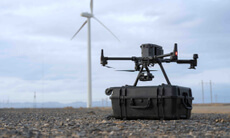Have you ever wondered how quadcopters, which are multi-directional and don't really have a front or rear, still manage to navigate? This is all down to a little device called an ESC, or Electronic Speed Controller. This is what translates a pilot's controls into precise instructions sent to the motors to control movement.
Inner workings
Multi-rotor aircraft are controlled by adjusting the speed of the motor and in turn the speed at which the aircraft's propellers spin. It increases or decreases its height by increasing or decreasing motor speed. It flies forward by increasing the speed of the rear propellers, and vice versa, and goes left by running the right hand propellers faster. Turns are achieved by taking advantage of the fact that two motors spin clockwise and two counter-clockwise, and then precisely adjusting the speed of each individual motor. The process of doing so starts with the aircraft's flight controller which receives the pilots instructions, then translates them into digital commands which it sends to the ESC. The ESC in turns interprets these instructions and increases or decreases the voltage that to each individual motor.
Active Braking
DJI ESCs support Active Braking, a feature that increases agility and conserves energy. Put plainly, what Active Braking does is to increase the motor's voltage when braking is initiated so that the time and distance before the aircraft slows to a hover is minimized. While the braking is happening, the motor is automatically put into generator mode so that instead of its mechanical energy being turned into heat energy and going to waste, it is turned into electric energy that is sent back to the battery, charging it up.
The Active Braking feature increases flight performance and efficiency. To further increase the agility and responsiveness of the aircraft, DJI ESCs run at high frequencies that more accurately translates the pilot's control signals to instructions sent to the motors so that flight is smooth and response immediate.
Integration and Intelligence
The ESC in the Phantom 4 is the world's first ESC designed as a System on a Chip (SoC) solution. This means that the micro controller unit, power management unit and other electronics which would usually all be separate modules are integrated in a single chip. This means an overall smaller size, lower weight, and boosted flight times.
The SoC is built using automotive-grade components to ensure that they are able to handle stress and a variety of tough conditions. Before a design goes into production, a complete Electromagnetic Compatibility Test is run, to ensure that its radiated emission, electrostatic discharge immunity and RF electric field immunity is within the strict standards defined by DJI engineers. ESC, motors and propellers are stress tested together for over 2000 hours in demanding, high temperatures to ensure its durability and ability that it is able to perform at high precision, with fast response to commands.
Simplicity and Reliability
Integration into a single chip also reduces the number of components and with it lowers the number of possible points of failure. Along with the regular analog connection, a digital connection provides redundancy to prevent the ESC losing connection with the main controller. Taken together, this results in greatly improved reliability for the aircraft.
DJI's ESCs are carefully designed to best fit each platform and its use case. Sine-wave ESCs are used where efficiency and power is of importance, while square-wave ESCs are used in compact systems where size and weight need to be kept low.
Another focus of the design process is ease of use. While many ESCs need to be calibrated manually, especially when building your own aerial platform, DJI's Intelligent ESCs (iESCs) sense minute changes in the motor's direction, acceleration and other parameters and automatically adapts to it for optimized stability and control precision.
The moment a motor is powered on, it performs an intelligent self-check to ensure that it is in good working condition. While the motors are running, it is constantly gathering information about its own status, including speed, voltage, temperature, voltage, current, and more, and sends the data back to the main controller via the ESC. The main controller analyzes the data and makes decision based on the data in real-time, in addition to saving a log of the data for diagnosing problems in the future.
Intrigued by the Phantom 4? Stop by the DJI Online Store and make it yours!



